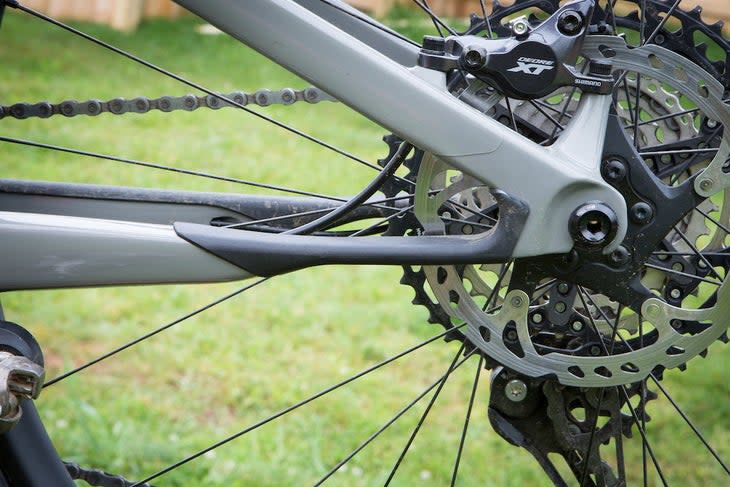Mountain Bikes Don’t Need to Be Complicated: 5 Places Where Less Is More
This article originally appeared on Outside
This post originally appeared on Pinkbike.com
I’ve already complained that some of the latest innovations cooked up by the bike industry could add more complexity than they're worth. But it's not all bad news. There are also some good ideas out there that make bikes both simpler and better.
In contrast to overly complicated suspension designs or added electronics, sometimes good design is about asking what you don't need. At its best, simplicity means making a bike lighter, quieter, cheaper, easier to maintain and more reliable. But it can be more than that. There's something elegant and ingenious about a simpler solution that performs just as well.
Here are a few examples of where less is more.
Flex Pivots

Single-Ring Drivetrains
To keen mountain bikers, the benefits of one-by may be so obvious that it almost goes without saying. They have allowed us to do away with a front shifter, front derailleur, cable, and (usually) a chain guide too, while still providing a wide range of gears. But to a novice rider, the simplicity of the single shifter is even more beneficial. They're not just simpler to install and maintain, they're simpler to ride because you only have one shifter and a continuous spread of sequential gears to think about.
And although they're not exactly new, you can now buy an entry-level bike with a decent single-ring drivetrain. For those who are just getting started in the sport, that's a very good thing.
Tech editor Mike Levy enjoying a Kona Process 134, despite its lonely pivot.
(Good) Single-Pivot Suspension
I'm sure that defending single pivots is going to draw a lot of flak, but here we go. Two criticisms are levelled at single pivot bikes. The first has to do with braking and applies to linkage-driven single-pivot bikes (like you’d find on a Kona or Commencal) as well as true single pivots (as used by Orange and Starling).
The main reason to use a Horst-link layout (which is the most common design these days) over a linkage-driven single pivot is to reduce and tweak the anti-rise characteristic, which is how the brake force acts on the suspension. This is claimed to allow the suspension to move more freely over bumps while braking. But in reality, this just isn't much of an issue. In fact, high anti-rise values typical of single pivots help them to resist brake dive, making them more stable under braking, and I think this effect is far more noticeable. For what it's worth, a lot of World Cup and EWS races have been won on linkage-driven single-pivot bikes over the years, from the likes of Commencal, Kona, Nukeproof, Cannondale, Honda and Saracen.
The second criticism only applies to true single-pivot bikes, where the shock is mounted directly to the swingarm. They generally lack progression from the frame, which means any progression or 'ramp up' in the suspension forces has to come from the shock. And with a progressive linkage, the damping forces also increase toward the end of the travel, further helping to prevent bottom-out.
First off, it's worth pointing out that some multi-pivot designs, such as Specialized's Stumpjumper Evo, don’t offer more progression (drop in leverage ratio) than could be achieved with a single pivot.
Besides, air shocks make tuning the progression of the spring with volume spacers easy, while the latest air springs with added negative volume or progressive coil springs mean modern shocks suit a linear leverage curve much better than they used to, diminishing the benefit of a progressive linkage.
Sure, with a progressive linkage the damping forces increase throughout the travel as well as the spring rate, and this is harder to replicate with the shock. But not everyone agrees the travel-dependent damping rates which come with progressive linkages are a good thing. That's why Cannondale built a downhill bike with a progressive link to drive the (coil) spring and a linear one to drive the damper.
Despite all this, I do think that progressive linkages have advantages from a performance standpoint, at least with many of the shocks that are available today. But with the right shock, single pivots can work very well indeed. Where I live, I know people who swap frame bearings multiple times a year; for them, the benefits of a single pivot could greatly outstrip the downsides.
Sometimes (maybe even usually) the answer is more boing. (Photo: Eric Mickelson)
More Travel
There are a lot of complicated ways of trying to optimize suspension performance: fancy linkages, expensive shocks, idlers. But there's only one surefire way to help a bike smooth out the bumps: give it more suspension travel.
Increasing travel doesn't necessarily increase weight, cost or complexity, but it fundamentally changes how effectively the bike can absorb impacts. And while not everybody wants a well-cushioned ride, you can run a long-travel bike as firm as you like by running less sag, using a lockout or adding volume spacers, but you can't run a short-travel bike as soft as you like, or it will bottom out.
I'm not saying that everybody should ride a downhill bike, but giving a trail bike 10 millimeters more travel might be a simpler and more effective way of improving tracking, grip, and comfort than a more complicated suspension design.

SRAM’s H2 rotors are available in 220 millimeter diameter and two millimeters thick.
Big Rotors
Similarly, there are a lot of complicated ways of improving braking performance like two-piece rotors, finned brake pads and lever cams. Most of these add cost, and sometimes issues too. Finned pads often rattle, and lever cams amplify inconsistency or sponginess in the hydraulic system.
In contrast, bigger rotors improve power, cooling, and consistency without adding complexity. A 220 millimeter rotor will boost power by about 10 percent when compared to a 200 millimeter rotor, while also providing more surface area to dissipate heat. Sure, they weigh more, but the disc is only about 25 grams heavier in the case of SRAM's HS2 rotors, and the extra weight is a positive for absorbing heat during heavy braking. To make things even simpler, you could try 220 millimeter rotors with two-pot brakes instead of 200 millimeter rotors with four-pots; two-piston brakes are easier to maintain, and the weight and power should be comparable.

Okay that’s taking simplicity a bit far. (Photo: Erick Gonzalez)
Bottom Line
I don't want to come across as a Luddite. I like technology that makes bikes perform better, even by only a small amount. I'm a big fan of innovations like long-travel dropper posts, 12-speed cassettes and adjustable geometry because they offer a tangible benefit, at least sometimes. But in the cases where a design with fewer parts performs just as well in the real world, I'd rather take the simpler approach every time. Remember that bike brands want to stand out from the crowd and convince you their bike has an edge over its rivals. It’s much easier to do that by asking what they can add than what they could take away.
For exclusive access to all of our fitness, gear, adventure, and travel stories, plus discounts on trips, events, and gear, sign up for Outside+ today.

